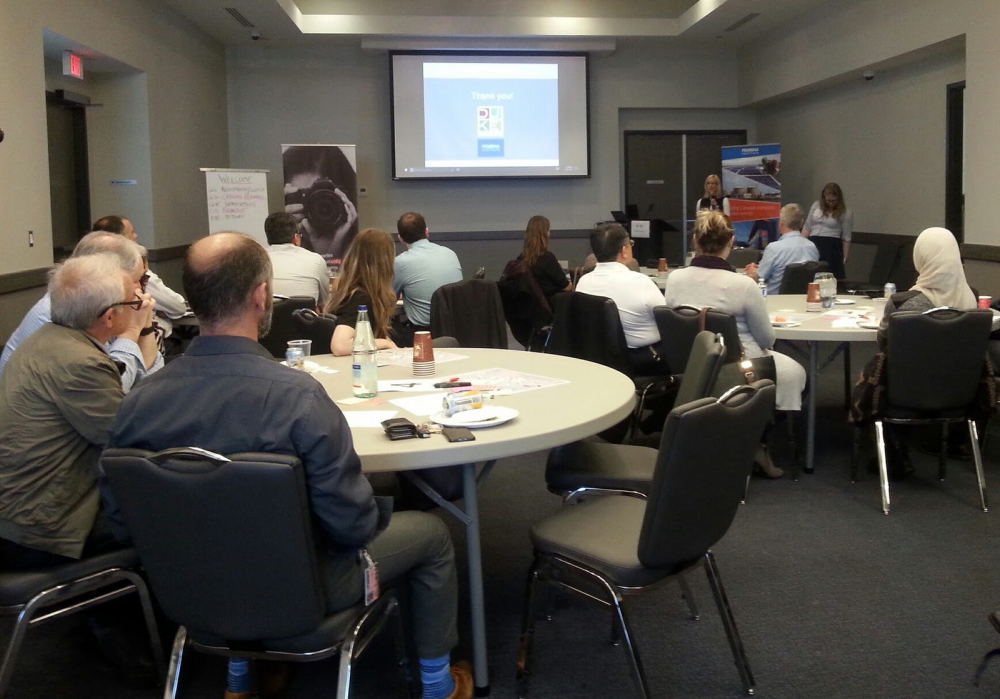This spring marked a milestone for both the Pembina Institute and Canada: we kicked off the country’s first neighbourhood-led freight forum. In our work on reducing emissions from goods movement, we’ve discovered there are immense opportunities to improve efficiency in urban freight. With this in mind, the Pembina Institute has teamed up with the DUKE Heights Business Improvement Area (BIA) to pilot a neighbourhood freight forum (NFF). The DUKE Heights BIA, located in northwest Toronto, has a high amount of industrial, retail and manufacturing businesses — there’s even a large fuel terminal. With high volumes of freight traffic in the neighbourhood, it’s a perfect area to start identifying and testing solutions to make freight more efficient.
At the kick-off meeting for the NFF in April, we brought together approximately 40 participants, including government representatives, the local city councillor, and industry — including large shippers and local businesses — to discuss and learn more about their own challenges and issues with goods movement in the area. The issues that we heard were not entirely surprising: traffic congestion, lack of available parking, conflict with other modes of transportation (e.g. cyclists) and lack of quality and accessible data were all key challenges.
Traffic congestion was by far the issue most raised — given the volume of traffic in the area, the construction around Toronto’s new subway stations and the limited arterial and inner road network within the area. Other factors contributing to congestion included small intersections unable to accommodate large turning trucks, timing of traffic lights and the concentration of demand at certain times in the day, especially the morning peak.
We also heard about the link between trucking and other modes of transportation. The existing bike lanes, particularly on Finch Avenue, are often viewed as unsafe because they offer no separation — and therefore little protection — between cyclists and the large delivery trucks using the road. In addition, large blocks mean that pedestrians have long distances to walk in an environment that sometimes feels unpleasant or unsafe. The participants also expressed a desire for greater access to transit in the neighbourhood. It was noted that as the neighbourhood population grows and these alternate modes of transportation become more prevalent, more conflicts and safety concerns may arise.
These challenges are not unlike most neighbourhoods in urban cities, especially within the Toronto. It’s a common occurrence for service and delivery trucks to circle neighbourhoods to find parking (which contributes to congestion and air pollution), or being forced to park illegally. Unless we act now to find solutions, these inefficiencies will continue, especially as more people and businesses move into urban centres.
Rolling up our collective sleeves
This is why getting boots on the ground and working together to identify local challenges is so important. Gaining insight from local businesses and freight receivers who drive the majority of decisions about the timing and frequency of deliveries can help us understand the challenges they face, and then begin to explore ways to reduce traffic and improve local air quality.
Over the summer we will analyze what we heard, talk to freight experts, research what other jurisdictions are doing, and begin to identify what solutions might work for the DUKE Heights area. What we do know is that there is likely going to be a suite of solutions, which could include improving traffic signals, establishing local delivery plans, providing driver education to improve fuel efficiency, delivering packages off-peak or even establishing a local freight village. The lessons we learn in DUKE Heights can be applied to other neighbourhoods in Toronto, and right across Canada. We are excited to talk to more local businesses, and engage with policy makers to implement solutions that are right for neighbourhoods.
To find out more about our Neighbourhood Freight Forum, you can go to our website at http://www.pembina.org/freightforum, follow us on social media and sign up for our newsletter to receive updates.






